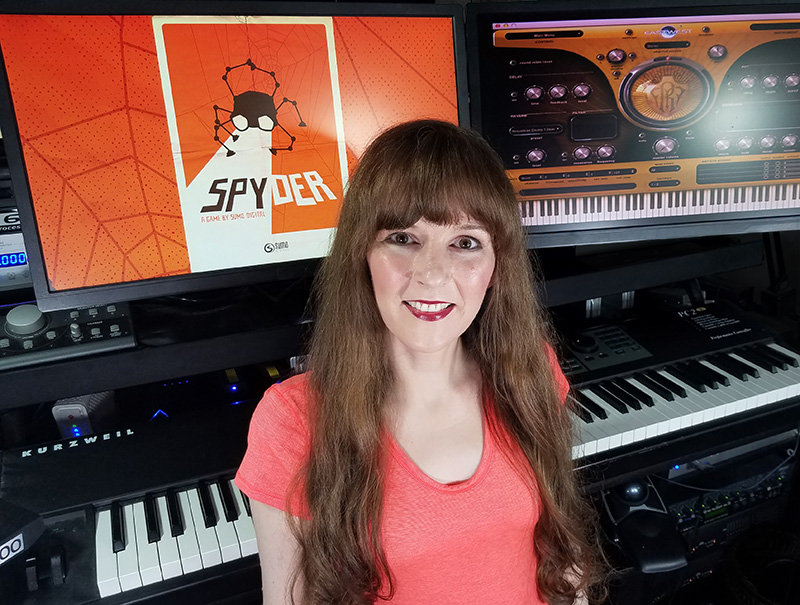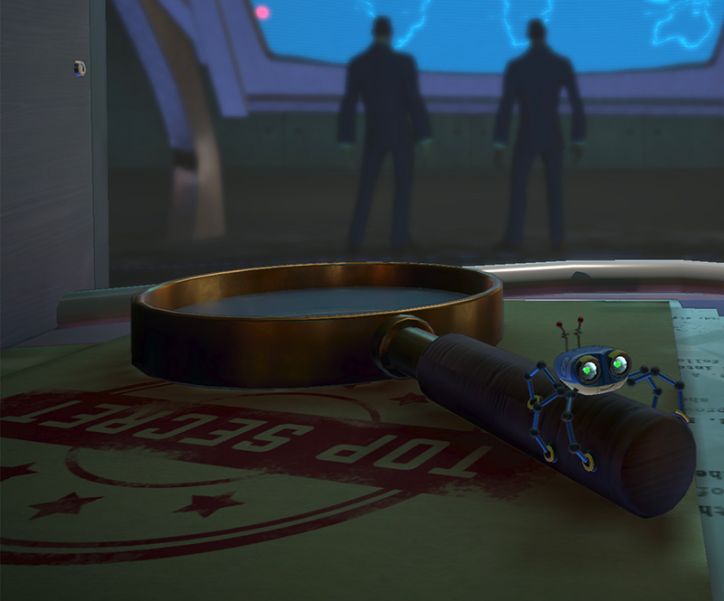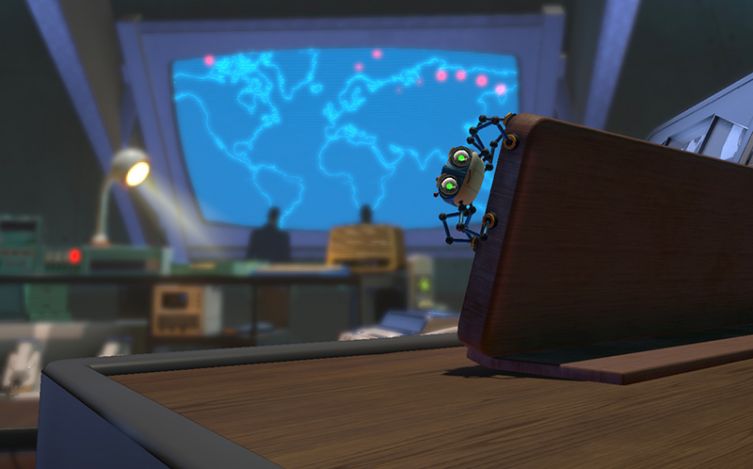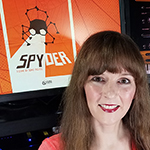Trending
Opinion: How will Project 2025 impact game developers?
The Heritage Foundation's manifesto for the possible next administration could do great harm to many, including large portions of the game development community.

Featured Blog | This community-written post highlights the best of what the game industry has to offer. Read more like it on the Game Developer Blogs or learn how to Submit Your Own Blog Post
Second of a 2-part series. Game composer Winifred Phillips delves into the dynamic music system for the recently-released SPYDER video game, developed by Sumo Digital for Apple Arcade. Part 2 explores the action system (including many video examples).


By Winifred Phillips | Contact | Follow
Welcome! I'm video game composer Winifred Phillips, and I'm glad you've joined us for this continuation of our discussion of the dynamic music system in the video game Spyder! As you may recall from our previous discussion, Spyder is a spy thriller set in a retro world that's vibrant with the famously over-the-top music and aesthetic of the late 1960s to early 1970s. The game was developed by Sumo Digital for the popular Apple Arcade gaming platform. The protagonist is an intelligent gadget resembling a tiny robotic spider. This device, named "Agent 8," was created by an elite British spy organization. As the hero of the game, Agent 8 undertakes high-stakes espionage in order to defeat a sprawling evil organization known as S.I.N.! Sumo Digital recently released a developer diary video about the making of the music of SPYDER, so let's check that out:
As you could see from the video, the Spyder video game features a dynamic music system designed to convey the iconic 1960s style of a classic spy thriller. In this two-part article series, we've been exploring how that system was created.
 During the previous article, we explored how the dynamic music system of Spyder deploys a large assortment of discrete atmospheric compositions in a semi-random triggering scheme and with scalable emotional intensity during exploration gameplay. If you haven't had a chance to read that article, you can check it out here.
During the previous article, we explored how the dynamic music system of Spyder deploys a large assortment of discrete atmospheric compositions in a semi-random triggering scheme and with scalable emotional intensity during exploration gameplay. If you haven't had a chance to read that article, you can check it out here.
In this article, we'll be moving on to a discussion of the interactive system for action music in the Spyder game. Agent 8 divides his time between stealthy intelligence gathering and frantic missions to thwart the dastardly schemes of the top agents of S.I.N. When clandestine operations must be set aside in favor of bold plans, Spyder swings into action, and the music ramps up to increase the sense of epic stakes. So let's take a look at how the action music of Spyder makes Agent 8 feel like an awesome hero!
In Spyder, action music is structured in vertical layers, with the instrumental texture building into more complex and propulsive mixes that flow seamlessly into each other as events proceed. The way in which the layers are combined will vary depending on the layout of the game level and the tasks that Agent 8 is asked to perform. The result is a dynamic musical system that reacts quickly and smoothly to the actions of the player. For instance, during one of Agent 8's perilous missions, he is smuggled on board an enemy bomber plane that's about to attack a cargo ship carrying humanitarian aid. Agent 8's goal throughout this mission is to disable the bomber plane as best he can, and prevent it from reaching its objective. Early gameplay onboard the bomber consists of careful navigation through the bowels of the plane, accompanied by stealthy ambient music. However, once our multi-legged hero reaches the plane's engine, things begin to heat up.
disable the bomber plane as best he can, and prevent it from reaching its objective. Early gameplay onboard the bomber consists of careful navigation through the bowels of the plane, accompanied by stealthy ambient music. However, once our multi-legged hero reaches the plane's engine, things begin to heat up.
Because of the nature of this level, action-oriented gameplay tends to occur in fits and starts, rather than in continuous sequences. Each action sequence is accompanied by the same interactive music composition, but each time that the action music is triggered, the number of layers changes. In order to make this possible, I composed the music so that every single instrument could be isolated into its own recording, making sure to create the most instrumental layers possible. I then submitted these recordings to the audio team at Sumo Digital as a large collection of instrumental music files that could be mixed and matched. All the recordings were labeled according to an emotional intensity scale, so that they could be incorporated appropriately as the action ramped up, and removed from the mix whenever it made sense to do so. Let's take a look at an example.
Early in the Sky High Spy level, Agent 8 works to drain the plane's engine of its oil supply. During this, the action music begins as a relatively low-keyed jazz groove featuring keyboards, vibraphone and some light synth. Let's check out how that sounds in-game:
Later, Agent 8 works to flood the engine of the plane with coolant. The action music is triggered again, except now it also includes drums and bass support for added momentum:
Finally, while attempting to defuse a bomb, Agent 8 is dropped along with the bomb out of the belly of the plane. At this point, Agent 8 must attempt to explode the bomb in mid-air so that it doesn't reach its target. While this is going on, the action music appears in its full-mix version, complete with a robust saxophone choir and orchestral string section.
In the case of the Sky High Spy level, the action music is triggered in separate instances with custom mixes that scale in intensity. However, the actual mixing changes are happening off-stage, so to speak. The player doesn't get to experience these changes in real time. In other levels of the Spyder video game, the action music makes these dynamic changes on the fly while the track is playing. Let's check out how that worked.
 At one point during the game, Agent 8 gets shot into space on board an out-of-control space capsule that has been sabotaged by the evil agents of S.I.N. In our last article we examined how the ambient music system worked aboard that damaged space ship. Now, let's check out how the action music functions during more exciting gameplay situations.
At one point during the game, Agent 8 gets shot into space on board an out-of-control space capsule that has been sabotaged by the evil agents of S.I.N. In our last article we examined how the ambient music system worked aboard that damaged space ship. Now, let's check out how the action music functions during more exciting gameplay situations.
Crawling along the outside of a damaged ship that's being pummeled by debris, Agent 8 makes his way to an electrical subsystem that he must rewire in order to repair the life support system for the struggling astronauts. As our little hero maneuvers his way across an electrical circuitboard, the action music begins in its simplest form. At this point, it's only a light synth melody and a few synthetic chords and effects. After completing the task of rewiring that board in expert fashion, Agent 8 makes his way to a second electrical system, and the music explodes into full-scale space disco complete with a funk guitar, high disco violins and lots of spacey musical synth effects. Let's see how that worked. Notice the layer activations taking place as the music plays:
This is a fuller realization of a vertical layering music system for the action sequences of the Spyder video game. To get a better understanding of how the system works, let's take a look at another example.
 In our previous article, we discussed the atmospheric music from The War Room level, so now let's see how action music proceeds. The structure of the action music system in The War Room is a great example of this vertical layering system, because it consists of a long sequence of events in which the layers are gradually added into the mix as Agent 8 progresses through the level. Because of the nature of gameplay and the implementation of a single dynamic vertical layering track that accentuates level progression, the War Room action music really exemplifies the vertical layering system in the Spyder game. The music begins when our hero crawls into the War Room mainframe computer in order to find a S.I.N. sabotage device and disable it. When you first hear the War Room action music, it consists of just three instruments: a piano, an electric piano, and a bass. By the time Agent 8 begins navigating a hazardous spinning deathtrap of computer reels, the music mix has been joined by some driving drums, vibes and marimba. Once our hero has disabled the sabotage device, the music breaks out into its full mix with full jazz brass, saxophone choir, and lots of quirky synths. Here's how that worked:
In our previous article, we discussed the atmospheric music from The War Room level, so now let's see how action music proceeds. The structure of the action music system in The War Room is a great example of this vertical layering system, because it consists of a long sequence of events in which the layers are gradually added into the mix as Agent 8 progresses through the level. Because of the nature of gameplay and the implementation of a single dynamic vertical layering track that accentuates level progression, the War Room action music really exemplifies the vertical layering system in the Spyder game. The music begins when our hero crawls into the War Room mainframe computer in order to find a S.I.N. sabotage device and disable it. When you first hear the War Room action music, it consists of just three instruments: a piano, an electric piano, and a bass. By the time Agent 8 begins navigating a hazardous spinning deathtrap of computer reels, the music mix has been joined by some driving drums, vibes and marimba. Once our hero has disabled the sabotage device, the music breaks out into its full mix with full jazz brass, saxophone choir, and lots of quirky synths. Here's how that worked:
So in this vertical layering implementation, the action music started with fairly sparse instrumentation and gradually built into a full mix by virtue of the addition of layers. If you'd like to hear the entire music composition for The War Room, you can check out this video posted by the developer Sumo Digital that features the full-length track:
Now let's take a look at an action music implementation scheme that proceeds in the opposite direction.
 In one of the more dramatic levels of the game, Agent 8 is charged with sabotaging a spy satellite. To complete this mission, our little hero must navigate across the satellite's wings: an array of solar panels. Once Agent 8 completes this journey, the action music triggers into a full mix complete with orchestral strings, full jazz band and rhythm section. But then the satellite's fiery booster rockets are engaged, introducing a new threat to Agent 8's mission. As soon as this happens, the music system deactivates the larger instrumental sections of the full mix, leaving only the core jazz rhythm section and a lead guitar. As the camera perspective pans across these fiery plumes of death, the music system triggers a new vertical layer in the form of ominous orchestral swells. Let's check that out:
In one of the more dramatic levels of the game, Agent 8 is charged with sabotaging a spy satellite. To complete this mission, our little hero must navigate across the satellite's wings: an array of solar panels. Once Agent 8 completes this journey, the action music triggers into a full mix complete with orchestral strings, full jazz band and rhythm section. But then the satellite's fiery booster rockets are engaged, introducing a new threat to Agent 8's mission. As soon as this happens, the music system deactivates the larger instrumental sections of the full mix, leaving only the core jazz rhythm section and a lead guitar. As the camera perspective pans across these fiery plumes of death, the music system triggers a new vertical layer in the form of ominous orchestral swells. Let's check that out:
The interactive music system of the Spyder video game is more complex and multifaceted than can be feasibly included in these two articles. By applying a narrow focus to specific ambient and action music systems within the Spyder game, we've taken abstract concepts and rendered them more concrete and applicable to our ongoing work as game music composers. I'm very proud to have composed music for the Spyder video game, and it was amazing to work with the outstanding audio team at Sumo Digital. I hope you've enjoyed this exploration of some of the dynamic systems in the Spyder video game score!
 Popular music from composer Winifred Phillips' award-winning Assassin's Creed Liberation score is currently featured as a part of the Assassin's Creed Symphony World Tour, which kicked off in 2019 in Paris with performances by a top 80-piece orchestra and choir. As an accomplished video game composer, Phillips is best known for composing music for games in five of the most famous and popular franchises in gaming: Assassin’s Creed, God of War, Total War, The Sims, and LittleBigPlanet. Phillips' other notable projects include music for the triple-A first person shooter Homefront: The Revolution (Deep Silver), and numerous virtual reality games from such accomplished developers as Supermassive Games, High Voltage Software, and Armature Studio. She is the author of the award-winning bestseller A COMPOSER'S GUIDE TO GAME MUSIC, published by the MIT Press. As a foremost authority on music for interactive entertainment, Winifred Phillips has given lectures at the Library of Congress in Washington DC, the Society of Composers and Lyricists, the Game Developers Conference, the Audio Engineering Society, and many more. Phillips’ enthusiastic fans showered her with questions during a Reddit Ask-Me-Anything session that went viral, hit the Reddit front page, received 14.9 thousand upvotes, and became one of the most popular gaming AMAs ever hosted on Reddit.
Popular music from composer Winifred Phillips' award-winning Assassin's Creed Liberation score is currently featured as a part of the Assassin's Creed Symphony World Tour, which kicked off in 2019 in Paris with performances by a top 80-piece orchestra and choir. As an accomplished video game composer, Phillips is best known for composing music for games in five of the most famous and popular franchises in gaming: Assassin’s Creed, God of War, Total War, The Sims, and LittleBigPlanet. Phillips' other notable projects include music for the triple-A first person shooter Homefront: The Revolution (Deep Silver), and numerous virtual reality games from such accomplished developers as Supermassive Games, High Voltage Software, and Armature Studio. She is the author of the award-winning bestseller A COMPOSER'S GUIDE TO GAME MUSIC, published by the MIT Press. As a foremost authority on music for interactive entertainment, Winifred Phillips has given lectures at the Library of Congress in Washington DC, the Society of Composers and Lyricists, the Game Developers Conference, the Audio Engineering Society, and many more. Phillips’ enthusiastic fans showered her with questions during a Reddit Ask-Me-Anything session that went viral, hit the Reddit front page, received 14.9 thousand upvotes, and became one of the most popular gaming AMAs ever hosted on Reddit.
Follow her on Twitter @winphillips or visit her website at winifredphillips.com.
Read more about:
Featured BlogsYou May Also Like